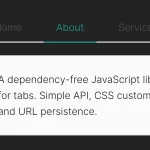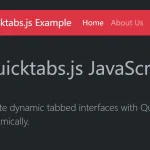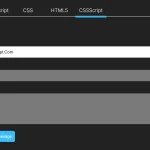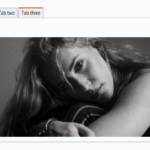| Author: | flkt-crnpio |
|---|---|
| Views Total: | 2,639 views |
| Official Page: | Go to website |
| Last Update: | July 3, 2016 |
| License: | MIT |
Preview:

Description:
Just another pure CSS tabs component which uses CSS3 transitions for smooth animations, and radio inputs for switching between tabbed panels.
How to use it:
The html structure for the tabs component assicated with 2 tabbed panels.
<div class="tabs">
<div class="tab-2">
<label for="tab2-1">Tab One</label>
<input id="tab2-1" name="tabs-two" type="radio" checked="checked">
<div>
<h4>Tab One</h4>
<p>Content One</p>
</div>
</div>
<div class="tab-2">
<label for="tab2-2">Tab Two</label>
<input id="tab2-2" name="tabs-two" type="radio">
<div>
<h4>Tab Two</h4>
<p>Content Two</p>
</div>
</div>
</div>The required CSS/CSS3 styles and radio button hack for the tabs component.
.tabs {
display: block;
display: -webkit-flex;
display: -moz-flex;
display: flex;
-webkit-flex-wrap: wrap;
-moz-flex-wrap: wrap;
flex-wrap: wrap;
margin: 0;
overflow: hidden;
}
.tabs [class^="tab"] label, .tabs [class*=" tab"] label {
color: #efedef;
cursor: pointer;
display: block;
font-size: 1.1em;
font-weight: 300;
line-height: 1em;
padding: 2rem 0;
text-align: center;
}
.tabs [class^="tab"] [type="radio"], .tabs [class*=" tab"] [type="radio"] {
border-bottom: 1px solid rgba(239, 237, 239, 0.5);
cursor: pointer;
-webkit-appearance: none;
-moz-appearance: none;
appearance: none;
display: block;
width: 100%;
-webkit-transition: all 0.3s ease-in-out;
-moz-transition: all 0.3s ease-in-out;
-o-transition: all 0.3s ease-in-out;
transition: all 0.3s ease-in-out;
}
.tabs [class^="tab"] [type="radio"]:hover, .tabs [class^="tab"] [type="radio"]:focus, .tabs [class*=" tab"] [type="radio"]:hover, .tabs [class*=" tab"] [type="radio"]:focus { border-bottom: 1px solid #fd264f; }
.tabs [class^="tab"] [type="radio"]:checked, .tabs [class*=" tab"] [type="radio"]:checked { border-bottom: 2px solid #fd264f; }
.tabs [class^="tab"] [type="radio"]:checked + div, .tabs [class*=" tab"] [type="radio"]:checked + div { opacity: 1; }
.tabs [class^="tab"] [type="radio"] + div, .tabs [class*=" tab"] [type="radio"] + div {
display: block;
opacity: 0;
padding: 2rem 0;
width: 90%;
-webkit-transition: all 0.3s ease-in-out;
-moz-transition: all 0.3s ease-in-out;
-o-transition: all 0.3s ease-in-out;
transition: all 0.3s ease-in-out;
}
.tabs .tab-2 { width: 50%; }
.tabs .tab-2 [type="radio"] + div {
width: 200%;
margin-left: 200%;
}
.tabs .tab-2 [type="radio"]:checked + div { margin-left: 0; }
.tabs .tab-2:last-child [type="radio"] + div { margin-left: 100%; }
.tabs .tab-2:last-child [type="radio"]:checked + div { margin-left: -100%; }That’s it. You can adjust or override the CSS styles as shown above to create your own styles.










